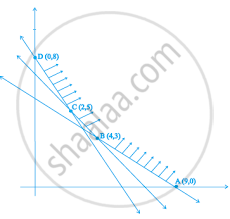Advertisements
Advertisements
प्रश्न
A company makes 3 model of calculators: A, B and C at factory I and factory II. The company has orders for at least 6400 calculators of model A, 4000 calculator of model B and 4800 calculator of model C. At factory I, 50 calculators of model A, 50 of model B and 30 of model C are made every day; at factory II, 40 calculators of model A, 20 of model B and 40 of model C are made everyday. It costs Rs 12000 and Rs 15000 each day to operate factory I and II, respectively. Find the number of days each factory should operate to minimise the operating costs and still meet the demand.
उत्तर
Let factory I be operated for x days and II for y days.
At factory I: 50 calculators of model A and at factory II, 40 calculators of model A are made everyday.
Company has orders of atleast 6400 calculators of model A.
∴ 50x + 40y ≥ 6400
⇒ 5x + 4y ≥ 640
Also, at factory I, 50 calculators of model B and at factory II, 20 calculators of model B are made everyday
Company has the orders of atleast 4000 of calculators of model B.
∴ 50x + 20y ≥ 4000
⇒ 5x + 2y ≥ 4000
Similarly for model C,
30x + 40y ≥ 4800
⇒ 3x + 4y ≥ 480
And x ≥ 0, y ≥ 0
It costs ₹ 12,000 and ₹ 15000 to operate the factories I and II each day.
∴ Required LPP is
Minimise Z = 12000x + 15000y subject to the constraints
5x + 4y ≥ 640 ......(i)
5x + 2y ≥ 400 .......(ii)
3x + 4y ≥ 480 .......(iii)
x ≥ 0, y ≥ 0 .......(iv)
Table for (i) equation 5x + 4y = 640
| x | 0 | 128 |
| y | 160 | 0 |
Table for (ii) equation 5x + 2y = 400
| x | 0 | 80 |
| y | 200 | 0 |
Table for (iii) equation 3x + 4y = 480
| x | 0 | 160 |
| y | 120 | 0 |

On solving equation (i) and (iii), we get
x = 80, y = 60
On solving equation (i) and (ii) we get
x = 32 and y = 120
From the graph, we see that the feasible region ABCD is open unbounded whose corners are A(160, 0), B(80, 60), C(32, 120) and D(0, 200).
Let us find the values of Z.
| Corner points | Value of Z = 12000x + 15000y | |
| A(160, 0) | Z = 12000(160) + 0 = 1920000 | |
| B(80, 60) | Z = 12000(80) + 15000(60) = 1860000 | ← Minimum |
| C(32, 120) | Z = 12000(32) + 15000(120) = 2184000 | |
| D(0, 200) | Z = 0 + 15000(200) = 3000000 |
From the above table, it is clear that the value of Z = 1860000 may or may not be minimum for an open unbounded region.
Now, to decide this, we draw a graph of 12000x + 15000y < 1860000
⇒ 4x + 5y < 620
And we have to check whether there is a common point in this feasible region or not.
So, from the graph, there is no common point.
∴ Z = 12000x + 15000y has minimum value 1860000 at (80, 60).
Factory I: 80 days
Factory II: 60 days.
APPEARS IN
संबंधित प्रश्न
Two tailors, A and B, earn Rs 300 and Rs 400 per day respectively. A can stitch 6 shirts and 4 pairs of trousers while B can stitch 10 shirts and 4 pairs of trousers per day. To find how many days should each of them work and if it is desired to produce at least 60 shirts and 32 pairs of trousers at a minimum labour cost, formulate this as an LPP
Solve the following Linear Programming Problems graphically:
Maximise Z = 5x + 3y
subject to 3x + 5y ≤ 15, 5x + 2y ≤ 10, x ≥ 0, y ≥ 0
Solve the following Linear Programming Problems graphically:
Maximise Z = 3x + 2y
subject to x + 2y ≤ 10, 3x + y ≤ 15, x, y ≥ 0.
Show that the minimum of Z occurs at more than two points.
Maximise Z = x + y, subject to x – y ≤ –1, –x + y ≤ 0, x, y ≥ 0.
A farmer mixes two brands P and Q of cattle feed. Brand P, costing Rs 250 per bag contains 3 units of nutritional element A, 2.5 units of element B and 2 units of element C. Brand Q costing Rs 200 per bag contains 1.5 units of nutritional elements A, 11.25 units of element B, and 3 units of element C. The minimum requirements of nutrients A, B and C are 18 units, 45 units and 24 units respectively. Determine the number of bags of each brand which should be mixed in order to produce a mixture having a minimum cost per bag? What is the minimum cost of the mixture per bag?
Maximise the function Z = 11x + 7y, subject to the constraints: x ≤ 3, y ≤ 2, x ≥ 0, y ≥ 0.
Feasible region (shaded) for a LPP is shown in Figure. Maximise Z = 5x + 7y.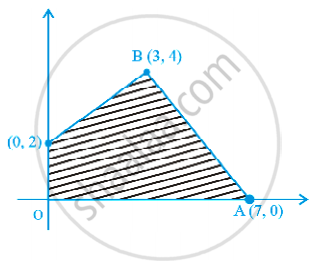
The feasible region for a LPP is shown in Figure. Find the minimum value of Z = 11x + 7y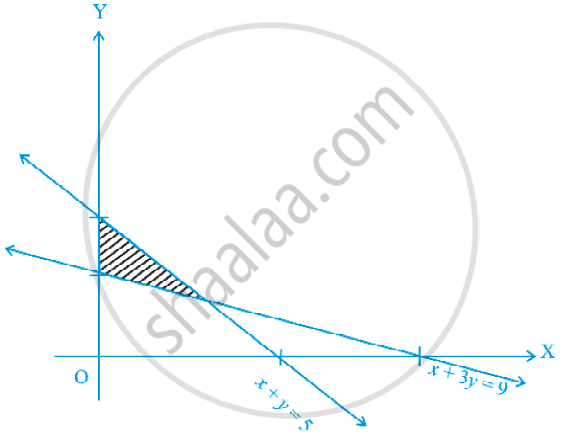
In figure, the feasible region (shaded) for a LPP is shown. Determine the maximum and minimum value of Z = x + 2y.
Refer to question 14. How many sweaters of each type should the company make in a day to get a maximum profit? What is the maximum profit.
Refer to question 15. Determine the maximum distance that the man can travel.
Maximise Z = x + y subject to x + 4y ≤ 8, 2x + 3y ≤ 12, 3x + y ≤ 9, x ≥ 0, y ≥ 0.
The feasible solution for a LPP is shown in Figure. Let Z = 3x – 4y be the objective function. Minimum of Z occurs at ______.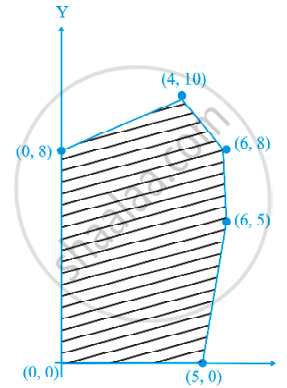
Refer to Question 27. (Maximum value of Z + Minimum value of Z) is equal to ______.
The feasible region for an LPP is always a ______ polygon.
Maximum value of the objective function Z = ax + by in a LPP always occurs at only one corner point of the feasible region.
In a LPP, the maximum value of the objective function Z = ax + by is always finite.
Based on the given shaded region as the feasible region in the graph, at which point(s) is the objective function Z = 3x + 9y maximum?
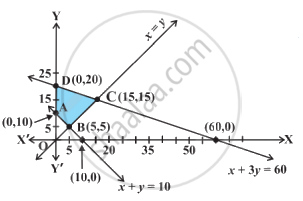
In linear programming infeasible solutions
In Corner point method for solving a linear programming problem, one finds the feasible region of the linear programming problem, determines its corner points, and evaluates the objective function Z = ax + by at each corner point. Let M and m respectively be the largest and smallest values at corner points. In case the feasible region is unbounded, m is the minimum value of the objective function.
If two corner points of the feasible region are both optimal solutions of the same type, i.e., both produce the same maximum or minimum.
In a LPP, the objective function is always ____________.
Maximize Z = 4x + 6y, subject to 3x + 2y ≤ 12, x + y ≥ 4, x, y ≥ 0.
The feasible region for an LPP is shown shaded in the figure. Let Z = 3x - 4y be the objective function. Minimum of Z occurs at ____________.

Maximize Z = 10×1 + 25×2, subject to 0 ≤ x1 ≤ 3, 0 ≤ x2 ≤ 3, x1 + x2 ≤ 5.
The feasible region for an LPP is shown shaded in the following figure. Minimum of Z = 4x + 3y occurs at the point.
